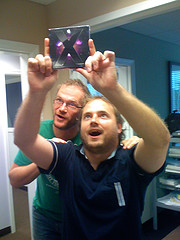Dan Benjamin at Hivelogic has some excellent guides for setting up all sorts of things on a Mac that relate to Rails development. His guide to installing MySQL on OSX is no exception. It takes you through the steps of downloading, compiling and installing the MySQL source code on your local machine. If you want MySQL on Leopard, this is probably the best way to go. There currently is no installer package for Leopard and while there is a package for Tiger, it is not without issues. Besides, it’s so much more fun to compile from source.
Category: Mac
Favorite Mac Applications
 Now that Leopard has been released, I’m going to order a new Macbook. Sorry PowerBook G4, you’ve served me well for many years, but its time for an upgrade.
Now that Leopard has been released, I’m going to order a new Macbook. Sorry PowerBook G4, you’ve served me well for many years, but its time for an upgrade.
As part of the upgrade, I took a quick inventory of the applications I use. In addition to the built-in apps such as Address Book, iCal, Mail and iTunes, there are several applications that have become necessities for me. When the new Mac shows up, I’ll be busy downloading and installing these popular applications:
- Adium
- CocoaMySQL
Colloquy- Firefox
- Growl and GrowlTunes
- NetNewsWire currently using an old version (2.0.1), will try the lite (free) version
- Quicksilver
- TextExpander
- TextMate and the Vibrant Ink Theme
Ruby on Rails is bundled with 10.5, so I don’t think there is much to do there–other than move my Rails projects. iTerm is nice when working on Rails, but it no longer seems necessary since Terminal is tabbed now.
I’ve been using Microsoft Office X since I’ve had the PowerBook and have very few complaints about it. So, I’ll probably stick with MS Office rather than spend the extra $79 on Apple’s iWork. I’m less positive about the other Microsoft product I use regularly, Virtual PC. There are one or two applications I need to run that have no Mac equivalent. Using Virtual PC has always been painfully slow for me. While Virtual PC will run better on a faster machine with more memory, Microsoft is no longer upgrading the product, so I think it is time to try something else. I’ll probably purchase Parallels or VMware Fusion as a replacement.
This list of applications was longer than expected and I’m sure I’ve missed a couple. I’ll update this post when I find out what those missing applications are. This will undoubtedly happen while I am franticly trying to complete a task on the new computer without the proper tool installed.
Leopard Day

So it’s Leopard Day. The official release is at 18:00 EDT, but mail order copies of Leopard have started arriving on desks around the world. There will be a sharp drop in productivity today as Mac fans upgrade their operating systems. If you are ready to upgrade, you might think about going for a clean install, it will be almost like getting a new Mac.
If you’re not quite ready to upgrade, check out, The Unofficial Apple Weblog’s 24 hours of Leopard, TUAW’s favorite new Leopard features–in 24 parts. If those shiny, new features don’t encourage you to loiter at the Apple Store tonight, I don’t know what will.
Photo by Obi Juan Kenobi
Quicksilver: Keeping Hands on Keyboards
The mouse and other pointing devices are great innovations for personal computing. Excessive use, however, can really slow you down. Since I’m not a fan of deceleration, I’ve been loving Quicksilver lately. Other Quicksilver users I’ve talked to share the same feeling. In addition to giving you quick, keyboard access to applications and files, it can do more advanced actions like providing speedy access to contacts in your address book. Many of these advanced actions are provided through a growing library of plugins. Applescripts can also be run with the tap of a couple keys. This makes Quicksilver exceedingly flexible. As a simple example, I made this basic Applescript that launches my most used applications in one go.
Unfortunately, Windows users are out of luck, Quicksilver is Mac only. But, there are alternatives. Launchy is quite popular and Lifehacker points to a promising alternative called Skylight. I don’t have any first hand experience with either of these Windows applications, but if they share at least some of Quicksilver’s features, I recommend trying them out.
Make Your Mac Quake in Your Presence
Well, it might not quake, but it can certainly do other things, providing you have some form of bluetooth device on you. Jesse David Hollington describes how to set up bluetooth proximity detection on a Mac. This allows one to execute an Applescript when a certain bluetooth device (like a phone) is within range and another script when the device is out of range. Jesse provides some scripts that inactivate/activate the screen saver and run isync among other things.
I simply pause iTunes when my phone goes out of range and play when the phone is back in range. Very nice.
This all relies on Proximity 1.0 to do the actual bluetooth detection. The system requirements for Proximity 1.0 state that it needs OS X 10.4 or higher, but it is working fine for me under 10.3.9.
via lifehacker